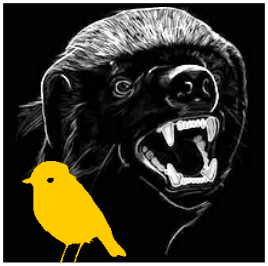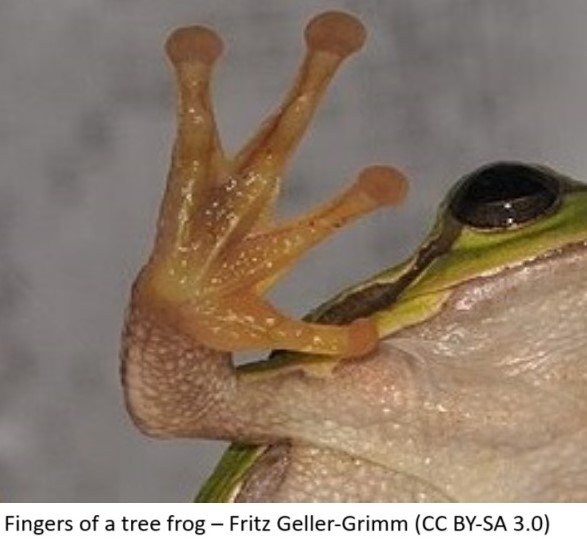Tetrapod fingers © Fritz Geller-Grimm, via Wikimedia Commons
Digital opposability in perching frogs.

Prof. Mumblebard claims: “Living amphibians consistently retain only four fingers on the forelimb. The missing digit is either number 5, homologous with our little finger, or number 1, homologous with our thumb. Textbooks contradict each other arbitrarily on this point because neither fossils nor embryos have revealed whether it is an outer or an inner digit of the hand that has been lost in frogs and salamanders. However, the distinction is academic because in such a primitive Class of vertebrates the inner and outer digits are functionally interchangeable anyway.”
Robin and the Honey Badger respond: “It’s important to decide which digit has been lost on the forelimb of amphibians because frogs expose the fallacy that the morphology of the hand is distinctive in humans and that the thumb can be equated with technological evolution in tool-making primates. Despite being low in the evolutionary hierarchy – in the sense that they belong to the same Class as the first tetrapods arising from fishes in the Permian – frogs show various degrees of opposability of the inner digit of the hand, from which humans differ in degree, not in kind. For example, certain digging frogs in Australia, which break out of epidermal cocoons after rain, have a somewhat opposable inner digit. The monkey frogs of central and South America – which climb slowly among thin stems – also show various gradations of opposability on both the fore- and hindlimbs and cling by a power grip rather than by suction or friction. A few species have even achieved a precision grip in which the inner digit of the hand can pick up food items by opposition with another digit – a skill lacking in most primates. Furthermore, certain frogs regarded as living fossils use their hands to feel for food items in muddy water and to cram prey into their mouths. Although these particularly primitive frogs show no opposability, the extreme sensitivity of the digit tips and their manipulation of objects are noteworthy. This is because many primates are inferior to some frogs in opposability of the inner digit of the forelimb, undermining any assumption that the thumb – as such – is a morphological hallmark of the highest mammals. Comparison with frogs shows that the unrivalled dexterity of the human thumb is due not to gross morphology – which remains similar to that of the first amphibians – but rather to the development of the human brain. The strongest clue that the inner digit on the forelimb of all amphibians really is a thumb is the occurrence of a pre-pollex on the innermost side of the hand in various lineages of frogs. Because it makes little sense to lose the thumb while producing an extra digit in its place, we can safely assume that amphibians have lost digit number 5, not number 1.”

Please join us here at the Bio-edge with your own comments. In the discussion below we encourage links to any evidence supporting either Prof. Mumblebard or Robin and the Honey Badger. Illustrations are welcome but please cite all sources or we may be forced under copyright to delete your comment.

